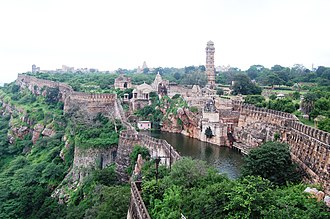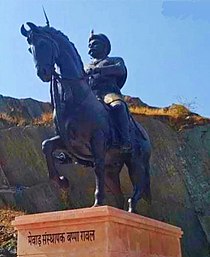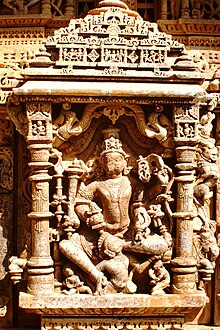
Bappa Rawal was a king of the Mewar kingdom in Rajasthan, India. The chronicles describe him as a member of the Guhila Clan, and some of them consider him to be the founder of the Guhila dynasty. He is credited with repelling the Arab invasion of India. He was renowned with the name "Maharaja Kaalbhoj", which meant a praise for his extremely powerful arms. He is identified as the ruler of the Guhila dynasty, and called by the names Kalabhoja, Shiladitya, and Khumana.
Nagabhata I was the founder of the imperial Gurjara Pratihara dynasty in northern India. He ruled the Avanti region in present-day Madhya Pradesh, from his capital at Ujjain. He may have extended his control over Gurjaradesa, which includes parts of present-day Gujarat and Rajasthan. He repulsed an Arab invasion from Sindh, probably led by Junayd ibn Abd al-Rahman al-Murri or Al Hakam ibn Awana.
Gahlot is a clan of Jats and Rajputs. They ruled a number of kingdoms including Mewar, Banswara, Dungarpur, Pratapgarh, Shahpura, Bhavnagar, Palitana, Lathi and Vala. The variations of the name include Gehlot, or Guhila.
Maharana Hammir Singh (1302–1364), or Hammir, was a 14th-century ruler of Mewar in present-day Rajasthan, India. Hammir Singh, was a scion of the cadet branch Rana of the Guhila dynasty, who regained control of the region, re-established the dynasty after defeating the Tughlaq dynasty, and captured present-day Rajasthan from Muslim forces of Delhi and became the first of the 'Rana' branch to become the King of Mewar with title of Maharana. Hammir also became the progenitor of the Sisodia clan, a branch of the Guhila dynasty, to which every succeeding Maharana of Mewar has belonged.

Ratnasimha was a ruler of the Medapata (Mewar) kingdom in present-day Rajasthan, India. He belonged to the Rawal branch of the Guhila dynasty, which ruled from the Chitrakuta fort. The last ruler of this branch, he was defeated by Alauddin Khalji during the Siege of Chittorgarh in 1303 CE.

The Chittorgarh, also known as Chittod Fort, is one of the largest living forts in India. It is a UNESCO World Heritage Site. The fort was the capital of Mewar and is located in the present-day city of Chittorgarh. It sprawls over a hill 180 m (590.6 ft) in height spread over an area of 280 ha above the plains of the valley drained by the Berach River. The fort covers 65 historic structures, which include four palaces, 19 large temples, 20 large water bodies, 4 memorials and a few victory towers.

The history of human settlement in the western Indian state of Rajasthan dates back to about 100,000 years ago. Around 5000 to 2000 BCE many regions of Rajasthan belonged as the site of the Indus Valley Civilization. Kalibangan is the main Indus site of Rajasthan, here fire altars have been discovered, similar to those found at Lothal.

The Kingdom of Mewar, sometimes known as Udaipur State, was an independent kingdom in Rajputana region of India, ruled by the Sisodia dynasty. It was established around the 6th century by the minor rulers of the Nagada-Ahar region of Udaipur and later, in the 10th century, it transformed into an independent state under Rawal Bharttripatta II.

The Mori was a kingdom that ruled over southwestern Rajasthan and northern Malwa from the 7th century and for a period of about 120 years. They controlled the Chittor Fort. The Mori Rajputs were probably the most powerful power in this region before the rise of the Gurjara-Pratihara dynasty. Mori is also considered a subclan of Parmar Rajputs.

The Chaulukya dynasty, also Solanki dynasty, was a dynasty that ruled parts of what are now Gujarat and Rajasthan in north-western India, between c. 940 CE and c. 1244 CE. Their capital was located at Anahilavada. At times, their rule extended to the Malwa region in present-day Madhya Pradesh. The family is also known as the "Solanki dynasty" in the vernacular literature. They belonged to the Solanki clan of Rajputs.
The Chahamanas of Jalor, also known as the Chauhans of Jalor in vernacular legends, were an Indian dynasty that ruled the area around Jalore in present-day Rajasthan between 1160 and 1311. They belonged to the Chahamana (Chauhan) clan of the Rajputs
Kirti-pala, also known as Kitu in vernacular legends, was an Indian king belonging to the Chahamana dynasty of Javalipura. A member of the Naddula Chahamana family, he carved out a principality for himself with Jalore at its capital. He ruled parts of southern Rajasthan as a feudatory of the Chaulukyas, and participated in their successful battle against Muhammad of Ghor in 1178 CE. He also fought with other Chaulukya feudatories, including Asala of Kiratakupa and the Guhila chief Samantasimha.
Banvir, also known as Banbeer was the ruler of Mewar Kingdom between 1536 and 1540. He was nephew of Rana Sanga, born to his brother Prithviraj and his cocunbine.

The siege of Chittorgarh occurred in 1303, when the Khalji ruler Alauddin Khalji captured and sacked the Chittor Fort, toppling the Guhila king Ratnasimha, after an eight-month-long siege. The conflict has been described in several legendary accounts, including the historical epic poem Padmavat, which claims that Alauddin's motive was to obtain Ratnasimha's beautiful wife Padmini; though this legend is considered historically inaccurate by most historians. Alauddin ordered the fort to be pelted with stones from his siege engines (munjaniqs). When the fort was stormed, Rajput women committed Jauhar while most of the warriors died defending the fort. The city of Chittor was completely sacked by Alauddin's army and several temples were desecrated.

The Samadhishvara Temple is a Hindu temple located in the Chittor Fort in Rajasthan, India. It is dedicated to Shiva, who is called "Samadhishvara", that is, "Lord of Samadhi". Epigraphic evidence suggests that the temple was constructed in the 11th century, and was further restored in the 13th and the 15th centuries.
Rawal Allata or Allata was a ruler of the Guhila dynasty. He was the son and successor of Rawal Bharttripatta II. He ruled from 951 to 971 CE. He continued the struggle with the Gurjara-Pratihara dynasty and is known to have slain the Gurjara King Devapal in 954. He was able to consolidate power after the weakening of the Gurjara-Pratihara. This hostility with the Pratiharas and the devastation of the empire eventually caused the empire to break into smaller dynasties like Paramaras of Malwa and Chauhans of Ajmer and Chaulukyas of Gujarat.
Rawal Jaitrasimha also known as Rawal Jaitra Singh was the ruler of the Guhila dynasty from 1213 to 1252. During his rule, the Guhila Kingdom attained a high political status. Ekalinga Mahatmya mentions his title as Rajakula (Rawal), his own inscriptions call him a Maharajadhiraja.
Samantasimha or Samant Singh was the ruler of the Guhila dynasty during the second half of the 12th century. He succeeded his father Kshemasimha. After the death of the powerful Chaulakya king Kumarapal, Samantsingh successfully invaded Gujarat. He was later deposed from Mewar. He sought refuge in Vagad and established himself there but was soon expelled from there as well.












